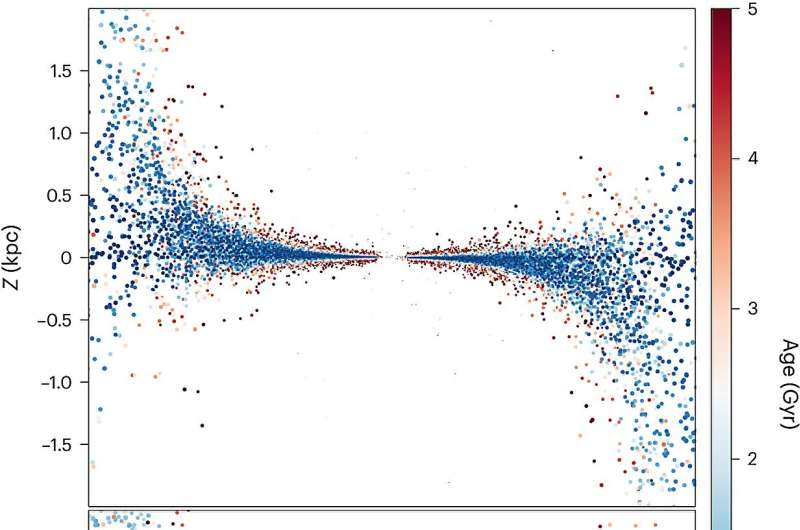September 25, 2023 report
This article has been reviewed according to Science X's editorial process and policies. Editors have highlighted the following attributes while ensuring the content's credibility:
fact-checked
peer-reviewed publication
trusted source
proofread
Model suggests Milky Way warp and flare due to tilt of dark halo

A trio of astrophysicists with Harvard and Smithsonian's Center for Astrophysics has found via computer modeling that the likely reason for the warp and flare of the Milky Way galaxy is a tilt of the dark halo. In their paper published in the journal Nature Astronomy, Jiwon Jesse Han, Charlie Conroy and Lars Hernquist describe their theories regarding the shape of the Milky Way galaxy and what their model showed.
When astronomers first figured out that the solar system is part of a larger spiral galaxy—the Milky Way—they assumed that the galaxy was flat. More recent data from telescopes and probes has shown that the Milky Way is slightly warped, mostly near the end tips of its spiral arms. And the most recent data from ESA's Gaia space telescope shows that one side of the galaxy bends slightly up while the other side bends slightly down. The reason is unclear, as most other spiral galaxies are mostly flat.
Most of the theories drawn up to explain the odd warping of the Milky Way have revolved around the idea of a collision between the Milky Way and another galaxy. Unfortunately, these theories have not been able to fully explain the observed shape. In this new effort, the researchers developed a new theory and created a computer model to back up their ideas.
The research team began by noting that some recent data has shown that the galactic halo is somewhat off-kilter compared to the disk that makes up the Milky Way. This suggested to them that the only thing that could have caused the halo to become unbalanced in such a way would be an imbalance in the dark matter that is believed to permeate the galaxy.
To find out if the idea might be plausible, the researchers built a computer model to represent the Milky Way, starting from its earliest days, when it was still forming. They then forced the galaxy's dark matter halo to become tilted at 25 degrees relative to the disk. Then, they let the model run, simulating the following 5 billion years.
They found that the Milky Way slowly formed into its current shape, strongly bolstering their theory. They further suggest that the tilt in the dark matter halo likely would have been caused by a collision with another galaxy.
More information: Jiwon Jesse Han et al, A tilted dark halo origin of the Galactic disk warp and flare, Nature Astronomy (2023). DOI: 10.1038/s41550-023-02076-9
Journal information: Nature Astronomy
© 2023 Science X Network





















